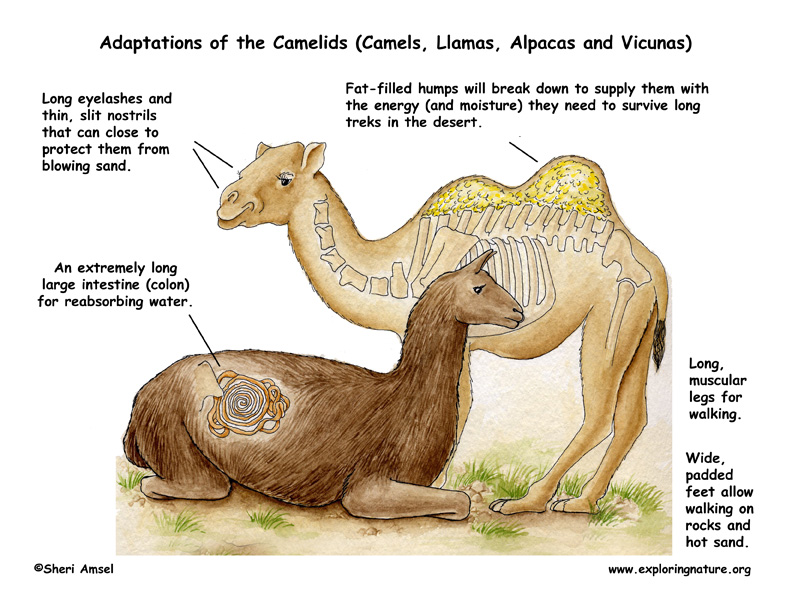

Adaptation in a population of living things happens as a result of an adaptive trait. This is any inheritable trait that increases its survival rate so that it can live longer, reproduce longer, and have more offspring (that also have that trait). Adaptive traits can improve an animal's ability to find food, make a safer home, escape predators, survive cold or heat or lack of water.
The camel has many adaptive traits for their life in the desert. They have wide feet for walking in sand. They have long eyelashes and thin, slit nostrils that they can close to protect them from blowing sand. They are adapted to survive a long time without water and food. They have an extremely long large intestine that absorbs every last drop of water from the foods they eat. On a long trip, the fat in their hump(s) will break down to supply their body with the energy it needs. By the end of a difficult trip, their humps may lay over on their side, emptied of the fat that filled them. When the camel finally reaches water, it can drink a huge amount very quickly to replenish itself, but it will take a little while to eat enough to rebuild its humps. These adaptive traits are all physical adaptations.
A behavioral adaptation for which the camel is famous is their reaction to the approach of a threat - they spit! The camel is a ruminant. This means that they have several stomach compartments where their tough, dry, grassy food needs to ferment and be broken down by special bacteria. Then they regurgitate it and chew it again - this is called “chewing their cud.” This may sound gross, but it allows them to live in habitats where other animals, like horses, would starve. Their cud is what they spit when stressed and because it is partially digested, it smells bad. This discourages predators from getting too close - and people too!
For Discussion and Critical Thinking:
The camel has adaptive traits that helps it survive in its dry environment
1. Why did humans start using camels to ride and pack supplies in desert habitats instead of horses?
2. Can you think of other animal that live in very dry environments? Name four and an adaptive trait that helps them survive the heat and lack of water.
4. Do you have any physical traits that help you survive? Discuss one.
When you research information you must cite the reference. Citing for websites is different from citing from books, magazines and periodicals. The style of citing shown here is from the MLA Style Citations (Modern Language Association).
When citing a WEBSITE the general format is as follows.
Author Last Name, First Name(s). "Title: Subtitle of Part of Web Page, if appropriate." Title: Subtitle: Section of Page if appropriate. Sponsoring/Publishing Agency, If Given. Additional significant descriptive information. Date of Electronic Publication or other Date, such as Last Updated. Day Month Year of access < URL >.
Amsel, Sheri. "Adaptations of the Camels" Exploring Nature Educational Resource ©2005-2024. December 13, 2024
< http://www.exploringnature.org/db/view/Adaptations-of-the-Camels >

